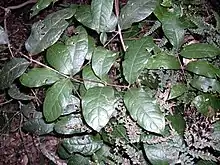Wilkiea huegeliana
Wilkiea huegeliana is a common small tree of rainforest in eastern Australia. Common names include common wilkiea, tetra beech, and veiny wilkiea. Originally described by French naturalist Louis René Tulasne, it was given its current name by Alphonse Pyramus de Candolle.
| Common wilkiea | |
|---|---|
 | |
| Wilkiea huegeliana at Macquarie Pass National Park, Australia | |
| Scientific classification | |
| Kingdom: | Plantae |
| Clade: | Tracheophytes |
| Clade: | Angiosperms |
| Clade: | Magnoliids |
| Order: | Laurales |
| Family: | Monimiaceae |
| Genus: | Wilkiea |
| Species: | W. huegeliana |
| Binomial name | |
| Wilkiea huegeliana | |
| Synonyms | |
|
* Mollinedia huegeliana Tul. | |
The natural distribution is from Mount Dromedary (36° S) near Narooma in south eastern New South Wales to Maryborough (25° S) in south eastern Queensland.[1] It has a preference for volcanic soils.[2]
The habitat of the common wilkiea is in the understorey of all forms or rainforest, except cool temperate forest subject to colder temperatures.
Description

Wilkiea huegeliana is a shrub or small tree achieving a height of 8 metres (26 feet), and a stem diameter of 10 cm (3.9 in).[1] The trunk is often crooked and irregular though not buttressed. The bark is smooth, brown or greyish, though can be somewhat scaly on larger plants.
The leaves measure 5 to 13 cm (2.0 to 5.1 in) long, and 1 to 5 cm (0.39 to 1.97 in) wide, and are opposite on the stem. Elliptic or oblong in shape, they usually have toothed margins, though rarely entire.[1] Rounded at the top, tapering at the stem end of the leaf. Dark and glossy above the leaf, dull and paler underneath. The leaf stalks are 3 to 11 mm long, and are very heavily and noticeably veined, particularly below the leaf.
A dioecious species, the plants are either male or female.[3] The yellow green fragrant flowers form from September to February.[1]
Fruit matures from May to September. The fruiting receptacle is shiny black in colour, 7 to 12 mm in diameter, without a stalk.[3] Several of them sit together on a tubular disk. Regeneration is from fresh seeds that stand out white on the darker forest floor, after having been dropped by birds.
Wilkiea huegeliana is most likely pollinated by Thrips setipennis, a species of thrips. These insects have been found in both male and female flowers.[4][5][6][7]
References
- Floyd, A.G. (1989). Rainforest Trees of Mainland South-eastern Australia. Inkata Press. p. 222. ISBN 0-909605-57-2.
- Fairley A, Moore P (2000). Native Plants of the Sydney District:An Identification Guide (2nd ed.). Kenthurst, NSW: Kangaroo Press. p. 54. ISBN 0-7318-1031-7.
- Harden, G.J. "Wilkiea huegeliana (Tul.) A.DC". PlanetNET. Retrieved 2009-08-15.
- Williams, G., Adams, P. & Mound, L.A. 2001. Thrips (Thysanoptera) pollination in Australian subtropical rainforests, with particular reference to pollination of Wilkiea huegeliana. (Monimiaceae). Journal of Natural History 35: 1-21
- Terry, Irene. "Thrips: the primeval pollinators?". Retrieved 2009-08-15.
- "Species Thrips setipennis (Bagnall, 1916)". Department of the Environment, Water, Heritage and the Arts. 2009-05-20. Retrieved 2009-08-15.
- "VECKANS VÄXT" (PDF) (in Swedish). Uppsala University. 2006-09-28. Retrieved 2009-08-15.